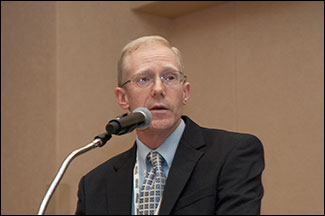Annoyances from the
National Cattle Evaluation
USMARC researcher explains what annoys him with the NCE.
by Kasey Brown, associate editor, Angus Journal®
LINCOLN, Neb. (June 20, 2014) — The National Cattle Evaluation (NCE) has brought about many advancements in genetic evaluation, but it still has some shortcomings, Mark Thallman, research geneticist with the U.S. Meat Animal Research Center (USMARC), told the Advancements in Genetic Prediction Committee at the 2014 Beef Improvement Federation Annual Meeting and Research Symposium in Lincoln, Neb., June 18-21.

“How can we expect people to look only at the EPDs and ignore actual birth weights if the best EPD we can provide is a pedigree average?” asked Mark Thallman.
Some of those shortcomings were brought to his attention as he helped his father-in-law buy a bull. The sale book only offered identical midparent expected progeny differences (EPDs) — the average of the trait value of the sire and the dam.
“How can we expect people to look only at the EPDs and ignore actual birth weights if the best EPD we can provide is a pedigree average?” he asked.
Without questioning the status quo, improvement is far less likely to occur, Thallman said. So, in the spirit of constructive criticism, he presented 10 questions to address current shortcomings of NCE.
1. Why do the largest cow-calf producers calculate within-herd EPDs? He speculated this happens because these herds believe their needs are not met by the purebred industry.
2. Why don’t we have fertility EPDs beyond stayability? Stayability was a great first attempt, he said. It worked to transition the seedstock industry to whole-herd reporting. However, it is not the end goal. Culling open cows is not the answer, either.
3. Why is there no attempt to account for genotype and environment interaction?
4. Why is there no attempt to evaluate components of longevity? He suggested collecting disposal codes and conducting survival analysis. Visual scores could be given for structural soundness, udder soundness and sheath scores.
5. Why do we avoid subjective information? There are EPDs for subjective traits like docility. There are standards for udder scoring, but no EPDs. Neither are there EPDs for structural soundness or sheath score.
6. Why don’t we reward breeders for submitting high-quality information? Thallman suggested that breeders who submit high-quality information could have higher accuracies. Those who do not submit data or who submit biased information could have lower accuracies and their animals’ EPDs could correspondingly be shrunken more toward the mid-parent mean. This could be done statistically as part of the evaluation, he added.
7. Why don’t we take advantage of orders of magnitude of improvements in computing power? He postured that any NCE could be calculated on a smartphone if the software were developed. “We could run far more sophisticated models on high-end computing hardware, and I believe we could improve accuracy and utility,” Thallman added.
8. Why do we assume that NCE has to run in software written specifically for this task? The NCE no longer qualifies as “big data,” he asserted. He thinks there is software that is capable of applying far more sophisticated models to the volume of data in the NCE.
9. Why are we so reluctant to improve the NCE? “Reranking bulls does not imply progress, but it is an inevitable consequence of progress,” he said.
10. Why is there a little progress on decision support? He suggested better tailoring selection to the needs of customers.
The 2014 BIF Annual Meeting & Research Symposium was hosted by the University of Nebraska–Lincoln, the U.S. Meat Animal Research Center and the Nebraska Cattlemen June 18-21 in Lincoln, Neb. The Angus Journal and LiveAuctions.tv provide comprehensive online coverage of the event at www.BIFconference.com. Visit the Newsroom for summaries, proceedings, PowerPoints and audio of the sessions; and the Awards page for announcements of award winners.
Editor’s Note: This summary was written under contract or by staff of the Angus Journal.Through an agreement with the Beef Improvement Federation, we are encouraging reprinting of the articles to those who will adhere to the reprint guidelines available on this site. Please review those guidelines or contact Shauna Rose Hermel, editor, at 816-383-5270. PowerPoints are posted with permission of the presenter and may not be reproduced in whole or in part without the express permission of the presenter.
API's coverage of the event is made possible through collaboration with BIF and sponsorship of LiveAuctions.tv. For questions about this site, or to notify us of broken links, click here.
Headquartered in Saint Joseph, Mo., API publishes the Angus Journal, the Angus Beef Bulletin, the Angus Beef Bulletin EXTRA, and the Angus Journal Daily, as well as providing online coverage of events and topics pertinent to cattlemen through the Angus Journal Virtual Library.



